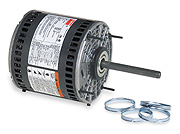
General-purpose motors are designed around industry standards and feature standard operating characteristics.
Definite-purpose motors are designed to meet specific application requirements with specific standards. Pump motors would be one example of a definite-purpose motor.
Special-purpose motors are designed around a specific application and must meet specific requirements. A vacuum motor is a prime example.
When selecting a motor, the three primary factors to think about are performance, electrical, and mechanical considerations.
PERFORMANCE
Performance considerations include motor type (shaded pole, permanent split capacitor, split phase, capacitor start, three-phase), horsepower, speed, and service factor. In some applications more than one motor type may work. In other applications an exact replacement will not be found, but a similar motor with slight differences in mechanical and electrical features will provide reliable operation.
ELECTRICAL
Electrical considerations include power, phase, and voltage. These criteria must be an exact match to the existing unit in the replacement motor. Insulation class and nameplate amperage are also electrical considerations but do not need to be an exact match.A good rule of thumb for the installer is to get a match as close as possible.It's okay for the replacement motor to have a lower nameplate amperage value. Should the replacement motor have a higher value, checking the ability of the electrical system to handle the added load is recommended.Insulation class (Class A, B, F, and H) refers to the thermal capacity of the materials used in the construction of the motor. Most motors used in today's HVAC applications are Class B designs. Contractors may come across a motor with a Class A rating, which is typically found in older motor designs. In general, it's okay to interchange Class A insulation systems with Class B insulation systems. You should give careful consideration and review when substituting a Class F or Class H rated motor in an application that used a Class B rated motor.

MECHANICAL
Mechanical considerations are further divided into three separate areas: frame size, enclosure, and bearing system.
Frame Size
The National Electrical Manufacturers Association (NEMA) has developed industry standards on frame size for general- and definite-purpose motors, including motor mounting dimensions, shaft dimensions, and any special callouts. Contractors should match the designated nameplate frame rating and then check the replacement motor's overall dimensions to make sure it will fit in the application. It is important to remember the NEMA frame size has no reference to the motor's overall size.
Enclosure
A motor's enclosure refers to its protective design and its ability to protect windings, bearings, and other internal components. There are two basic enclosure designs: open and enclosed. Open motors allow a free exchange of air to help control the motor's operating temperature, whereas enclosed motors prevent a free exchange of air. It is not uncommon to see both open and enclosed motor applications in HVAC applications. If the environment is somewhat clean, an open-type design for indoor applications is common, while enclosed designs are used primarily in outdoor applications. Dirty and dusty environments will use enclosed or enclosed fan cooled motors. Dirt and moisture must be kept from entering a motor. If the application exposes a motor to these conditions, then consider upgrading the motor's enclosure. Remember, it's always best to match the original motor's enclosure.
Bearing System
Ball and sleeve are two basic bearing designs. At one time sleeve bearing motors provided some cost savings as opposed to ball bearing designs, but that may not always be the case in today's market. Bearing and lubrication technology has improved so much through the years that the service life of the two motors are basically the same.
In fact, contractors can usually interchange bearing systems when looking for a replacement motor. Keep in mind for fractional HVAC applications of less than one horsepower, a sleeve bearing design works best if the application is sensitive to noise. Additionally, ensure the lubrication matches the manufacturer's specifications, and do not overfill when relubricating. This can cause a siphoning condition, which can result in the bearing system losing its oil. Sleeve bearing designs tend to run quieter than ball bearing designs. In fan applications, the air noise will typically mask any bearing noise; blower applications may be a little more sensitive to noise.
SELECTION AND INSTALLATION TIPS
Reprinted with permission from On the Job, October 2006, Grainger's quarterly newsletter for professional contractors. For more information, visit www.grainger.com/contractor.
Note: This information has been checked for suitability. However, a successful solution depends on individual accuracy, skill, and caution. For this reason, W.W. Grainger Inc. does not guarantee the result of procedure compliance or assume responsibility for personal injury or property damage to persons following these procedures.
Publication date: 10/23/2006

Report Abusive Comment